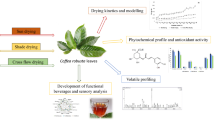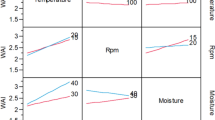Abstract
Coffee infusion experiments were conducted to infer how operational variables (time, temperature, mass to volume ratio, and grinding) might affect the efficiency and/or selectivity of compounds extraction. Although the different variables have extensively been reported independently, to the best of our knowledge, no experimental design was yet delineated to study the simultaneous effect of variables in coffee composition. This study fulfills this gap by constructing surface models that reflect the responses in a wide-ranging design space. The freeze-dried extracts were compared regarding the overall yield of extraction, carbohydrate content and composition, caffeine, chlorogenic acid (5-CQA) content, color, and viscosity. Temperature was the major factor for coffee extracts differentiation, regarding both overall and carbohydrates yield and composition. The extraction process efficiency is more related to galactomannans extraction than arabinogalactans. Varying operational conditions, coffee extracts with distinct chemical properties are obtained from the same roasted coffee, broadening their applications in food formulations.
Graphic abstract





Similar content being viewed by others
References
Gloess AN, Schönbächler B, Klopprogge B, D’Ambrosio L, Chatelain K, Bongartz A, Strittmatter A, Rast M, Yeretzian C (2013) Comparison of nine common coffee extraction methods: instrumental and sensory analysis. Eur Food Res Technol 236(4):607–627
Illy A, Viani R (2005) Espresso coffee: the science of quality. Elsevier, Amsterdam
Maeztu L, Andueza S, Ibañez C, Paz de Peña M, Bello J, Cid C (2001) Multivariate methods for characterization and classification of espresso coffees from different botanical varieties and types of roast by foam, taste, and mouthfeel. J Agric Food Chem 49(10):4743–4747
Oosterveld A, Voragen AGJ, Schols HA (2003) Effect of roasting on the carbohydrate composition of Coffea arabica beans. Carbohydr Polym 54(2):183–192
Nunes FM, Coimbra MA (2001) Chemical characterization of the high molecular weight material extracted with hot water from green and roasted arabica coffee. J Agric Food Chem 49(4):1773–1782
von Blittersdorff M, Klatt C (2017) Chapter 13 - The Grind—Particles and Particularities. In: Folmer B (ed) The Craft and Science of Coffee. Academic Press, Amsterdam
Andueza S, Vila MA, Paz de Peña M, Cid C (2007) Influence of coffee/water ratio on the final quality of espresso coffee. J Sci Food Agric 87(4):586–592
Andueza S, de Peña MP, Cid C (2003) Chemical and sensorial characteristics of espresso coffee as affected by grinding and torrefacto roast. J Agric Food Chem 51(24):7034–7039
Petracco M (2001) Technology IV: beverage preparation: brewing trends for the new millennium. In: Clarke RJ, Vitzthum OG (eds) Coffee: recent developments. Blackwell Science, London
Merritt MC, Proctor BE (1959) Extraction rates for selected components in coffee brew. J Food Sci 24(6):735–743
Parenti A, Guerrini L, Masella P, Spinelli S, Calamai L, Spugnoli P (2014) Comparison of espresso coffee brewing techniques. J Food Eng 121:112–117
Moroney KM, Lee WT, O’Brien SBG, Suijver F, Marra J (2015) Modelling of coffee extraction during brewing using multiscale methods: An experimentally validated model. Chem Eng Sci 137:216–234
Melrose J, Roman-Corrochano B, Montoya-Guerra M, Bakalis S (2018) Toward a new brewing control chart for the 21st century. J Agric Food Chem 66(21):5301–5309
Voilley A, Simatos D (1979) Modeling the solubilization process during coffee brewing. J Food Process Eng 3(4):185–198
Espinoza-Pérez JD, Vargas A, Robles-Olvera VJ, Rodríguez-Jimenes GC, García-Alvarado MA (2007) Mathematical modeling of caffeine kinetic during solid–liquid extraction of coffee beans. J Food Eng 81(1):72–78
Ribeiro JS, Teófilo RF, Augusto F, Ferreira MMC (2010) Simultaneous optimization of the microextraction of coffee volatiles using response surface methodology and principal component analysis. Chemom Intell Lab 102(1):45–52
Barbosa HMA, de Melo MMR, Coimbra MA, Passos CP, Silva CM (2014) Optimization of the supercritical fluid coextraction of oil and diterpenes from spent coffee grounds using experimental design and response surface methodology. J Supercrit Fluid 85:165–172
Ballesteros LF, Ramirez MJ, Orrego CE, Teixeira JA, Mussatto SI (2017) Optimization of autohydrolysis conditions to extract antioxidant phenolic compounds from spent coffee grounds. J Food Eng 199:1–8
Ballesteros LF, Teixeira JA, Mussatto SI (2014) Selection of the solvent and extraction conditions for maximum recovery of antioxidant phenolic compounds from coffee silverskin. Food Bioprocess Tech 7(5):1322–1332
Lopes GR, Ferreira AS, Pinto M, Passos CP, Coelho E, Rodrigues C, Figueira C, Rocha SM, Nunes FM, Coimbra MA (2016) Carbohydrate content, dietary fibre and melanoidins: composition of espresso from single-dose coffee capsules. Food Res Int 89:989–996
Oosterveld A, Harmsen JS, Voragen AGJ, Schols HA (2003) Extraction and characterization of polysaccharides from green and roasted Coffea arabica beans. Carbohydr Polym 52(3):285–296
Nunes FM, Coimbra MA (2002) Chemical characterization of galactomannans and arabinogalactans from two arabica coffee infusions as affected by the degree of roast. J Agric Food Chem 50(6):1429–1434
Nunes FM, Coimbra MA (2002) Chemical characterization of the high-molecular-weight material extracted with hot water from green and roasted robusta coffees as affected by the degree of roast. J Agric Food Chem 50(24):7046–7052
Passos CP, Rudnitskaya A, Neves JMMGC, Lopes GR, Evtuguin DV, Coimbra MA (2019) Structural features of spent coffee grounds water-soluble polysaccharides: towards tailor-made microwave assisted extractions. Carbohydr Polym 214:53–61
Nunes FM, Cruz ACS, Coimbra MA (2012) Insight into the mechanism of coffee melanoidin formation using modified “in Bean” models. J Agric Food Chem 60(35):8710–8719
Bekedam EK, Schols HA, van Boekel MAJS, Smit G (2006) High molecular weight melanoidins from coffee brew. J Agric Food Chem 54(20):7658–7666
Mestdagh F, Glabasnia A, Giuliano P (2017) Chapter 15—the brew—extracting for excellence. In: Folmer B (ed) The craft and science of coffee. Academic Press, Amsterdam
Angeloni G, Guerrini L, Masella P, Innocenti M, Bellumori M, Parenti A (2019) Characterization and comparison of cold brew and cold drip coffee extraction methods. J Sci Food Agric 99(1):391–399
Clarke RJ, Macrae R (1987) Coffee: vol. 2: technology. Elsevier, London
Wang X, Li K, Yang M, Wang J, Zhang J (2017) Hydrolyzability of mannan after adsorption on cellulose. Cellulose 24(1):35–47
Newman RH, Hemmingson JA (1998) Interactions between locust bean gum and cellulose characterized by13C n.m.r. spectroscopy. Carbohydr Polym 36(2):167–172
Nunes FM, Coimbra MA (1998) Influence of polysaccharide composition in foam stability of espresso coffee. Carbohydr Polym 37(3):283–285
Shin K-S (2017) The chemical characteristics and immune-modulating activity of polysaccharides isolated from cold-brew coffee. Prev Nutr Food Sci 22(2):100–106
Ferreira SS, Passos CP, Cepeda MR, Lopes GR, Teixeira-Coelho M, Madureira P, Nunes FM, Vilanova M, Coimbra MA (2018) Structural polymeric features that contribute to in vitro immunostimulatory activity of instant coffee. Food Chem 242:548–554
Passos CP, Moreira ASP, Domingues MRM, Evtuguin DV, Coimbra MA (2014) Sequential microwave superheated water extraction of mannans from spent coffee grounds. Carbohydr Polym 103:333–338
Bekedam EK, Loots MJ, Schols HA, Van Boekel MAJS, Smit G (2008) Roasting effects on formation mechanisms of coffee brew melanoidins. J Agric Food Chem 56(16):7138–7145
Hečimović I, Belščak-Cvitanović A, Horžić D, Komes D (2011) Comparative study of polyphenols and caffeine in different coffee varieties affected by the degree of roasting. Food Chem 129(3):991–1000
Fujioka K, Shibamoto T (2008) Chlorogenic acid and caffeine contents in various commercial brewed coffees. Food Chem 106(1):217–221
Moreira ASP, Nunes FM, Simões C, Maciel E, Domingues P, Domingues MRM, Coimbra MA (2017) Data on coffee composition and mass spectrometry analysis of mixtures of coffee related carbohydrates, phenolic compounds and peptides. Data Brief 13:145–161
Macrae R (1985) Nitrogenous components. In: Clarke RJ, Macrae R (eds) Coffee: volume 1: chemistry. Springer, Dordrecht
Ludwig IA, Mena P, Calani L, Cid C, Del Rio D, Lean MEJ, Crozier A (2014) Variations in caffeine and chlorogenic acid contents of coffees: what are we drinking? Food Funct 5(8):1718–1726
Crozier TWM, Stalmach A, Lean MEJ, Crozier A (2012) Espresso coffees, caffeine and chlorogenic acid intake: potential health implications. Food Funct 3(1):30–33
Bekedam EK, Schols HA, Van Boekel MAJS, Smit G (2008) Incorporation of chlorogenic acids in coffee brew melanoidins. J Agric Food Chem 56(6):2055–2063
López-Galilea I, De Peña MP, Cid C (2007) Correlation of selected constituents with the total antioxidant capacity of coffee beverages: influence of the brewing procedure. J Agric Food Chem 55(15):6110–6117
Acknowledgements
Thanks are due to the University of Aveiro and FCT/MCT for the financial support for the QOPNA research Unit (FCT UID/QUI/00062/2019) through national founds and, where applicable, co-financed by the FEDER, within the PT2020 Partnership Agreement, and to the Portuguese NMR Network. Guido R. Lopes and Cláudia P. Passos were supported by individual doc (SFRH/BD/104855/2014) and post-doc (SFRH/BDP/107881/2015) grants by FCT, respectively.
Author information
Authors and Affiliations
Corresponding author
Ethics declarations
Conflict of interest
The authors declare no conflict of interests.
Compliance with ethics requirements
This article does not contain any studies with human or animal subjects.
Additional information
Publisher's Note
Springer Nature remains neutral with regard to jurisdictional claims in published maps and institutional affiliations.
Electronic supplementary material
Below is the link to the electronic supplementary material.
Rights and permissions
About this article
Cite this article
Lopes, G.R., Passos, C.P., Rodrigues, C. et al. Modulation of infusion processes to obtain coffee-derived food ingredients with distinct composition. Eur Food Res Technol 245, 2133–2146 (2019). https://doi.org/10.1007/s00217-019-03318-9
Received:
Revised:
Accepted:
Published:
Issue Date:
DOI: https://doi.org/10.1007/s00217-019-03318-9




